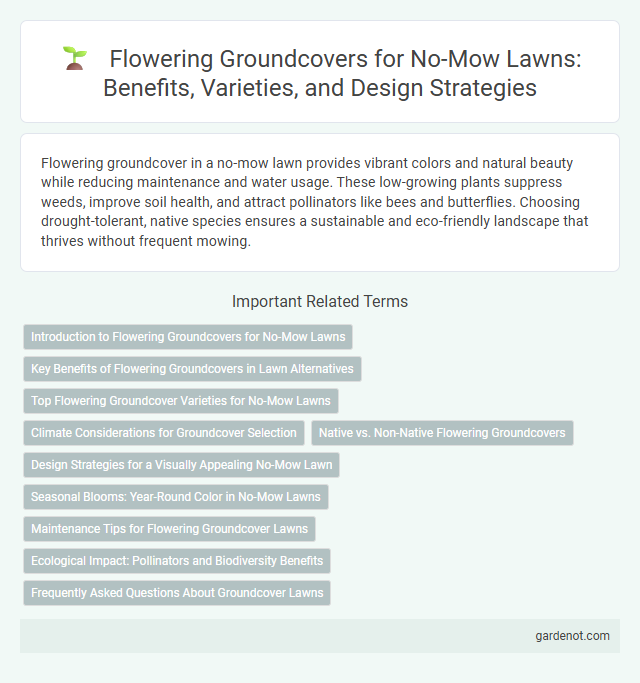Flowering groundcover in a no-mow lawn provides vibrant colors and natural beauty while reducing maintenance and water usage. These low-growing plants suppress weeds, improve soil health, and attract pollinators like bees and butterflies. Choosing drought-tolerant, native species ensures a sustainable and eco-friendly landscape that thrives without frequent mowing.
Introduction to Flowering Groundcovers for No-Mow Lawns
Flowering groundcovers such as creeping thyme, lamb's ear, and ajuga provide vibrant color and low-maintenance alternatives to traditional grass lawns, thriving with minimal mowing. These plants establish dense mats that suppress weeds, improve soil health, and attract pollinators, making them ideal for eco-friendly landscaping. Selecting species suited to local climate and soil conditions ensures durable, resilient no-mow lawns with continuous seasonal blooms.
Key Benefits of Flowering Groundcovers in Lawn Alternatives
Flowering groundcovers offer superior drought tolerance and require minimal maintenance, making them ideal for sustainable no-mow lawns. They enhance biodiversity by attracting pollinators such as bees and butterflies, contributing to a healthier ecosystem. These plants improve soil health through erosion control and natural nutrient cycling, reducing the need for chemical inputs.
Top Flowering Groundcover Varieties for No-Mow Lawns
Creeping thyme, sedum, and ajuga are top flowering groundcover varieties ideal for no-mow lawns due to their low maintenance and drought tolerance. These plants provide vibrant colors and attract pollinators like bees and butterflies while suppressing weeds effectively. Their ability to thrive in various soil conditions makes them perfect for creating sustainable, eco-friendly landscapes with minimal mowing.
Climate Considerations for Groundcover Selection
Selecting flowering groundcover for no-mow lawns requires careful consideration of local climate factors such as temperature ranges, precipitation patterns, and soil conditions. Drought-tolerant species like creeping thyme or sedum perform well in arid regions, while moisture-loving varieties such as ajuga thrive in wetter climates. Emphasizing native groundcover plants enhances ecosystem resilience and reduces maintenance needs in diverse climate zones.
Native vs. Non-Native Flowering Groundcovers
Native flowering groundcovers such as creeping phlox and wild strawberry provide essential habitat and support local pollinators, promoting biodiversity in no-mow lawns. Non-native varieties like creeping thyme or vinca may offer more vibrant blooms but can sometimes outcompete native plants and disrupt local ecosystems. Selecting native species encourages ecological balance and reduces the need for maintenance in sustainable no-mow lawn designs.
Design Strategies for a Visually Appealing No-Mow Lawn
Incorporate flowering groundcovers such as creeping phlox, ajuga, or sweet woodruff to create a vibrant, low-maintenance no-mow lawn that attracts pollinators and reduces water usage. Strategic planting in clusters and along pathways enhances texture and seasonal color, while selecting native species ensures resilience and adapts to local soil conditions. Combining flowering groundcovers with varying bloom times sustains visual interest year-round and supports ecosystem health.
Seasonal Blooms: Year-Round Color in No-Mow Lawns
Flowering groundcovers such as creeping thyme and sedum provide vibrant seasonal blooms that enhance no-mow lawns with year-round color. These low-maintenance plants thrive in diverse climates, requiring minimal water and mowing while attracting pollinators like bees and butterflies. Incorporating diverse flowering groundcover species ensures continuous floral display from spring through fall, maintaining aesthetic appeal and supporting local ecosystems.
Maintenance Tips for Flowering Groundcover Lawns
Flowering groundcover lawns require minimal mowing, which promotes healthier blooms and reduces stress on plants. Regular watering during dry periods and occasional trimming of overgrown areas help maintain dense, vibrant coverage. Applying a slow-release, balanced fertilizer in early spring supports robust growth and prolonged flowering throughout the season.
Ecological Impact: Pollinators and Biodiversity Benefits
Flowering groundcovers in no-mow lawns enhance ecological health by providing vital nectar and pollen sources for pollinators such as bees, butterflies, and hummingbirds. These plants increase biodiversity by creating habitats that support a range of insects and soil organisms, promoting ecosystem resilience. Their presence contributes to the stability of pollinator populations and supports surrounding native plant communities through improved cross-pollination.
Frequently Asked Questions About Groundcover Lawns
Flowering groundcover lawns offer an eco-friendly alternative to traditional grass, requiring less water, fertilizer, and mowing while promoting biodiversity with vibrant blooms. Common questions include which species thrive best in varying sunlight conditions and how to manage weeds without chemicals. Selecting native flowering groundcovers like creeping thyme or clover ensures durability and supports pollinator habitats in low-maintenance landscapes.
Flowering groundcover Infographic

 gardenot.com
gardenot.com